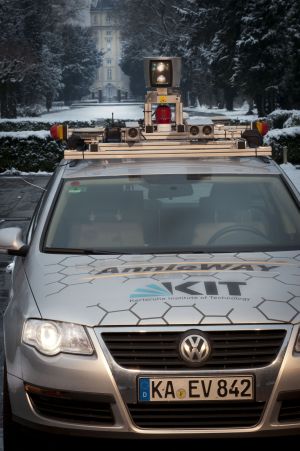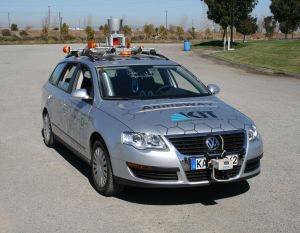Less accidents, less fuel consumption, and less traffic jams: Autonomous, computer-controlled vehicles have many advantages in road traffic. In particular, if many cars join to form long convoys. On May 14 and 15, 2011, ten research groups will meet in Holland for the first time and test convoy driving without drivers on an about 6 km long motorway section in the Grand Cooperative Driving Challenge (GCDC). KIT researchers involved in the AnnieWAY team will take part.
Autonomous vehicles are equipped with sensors that perceive the position, movement, and environment. From these data, a computer calculates the next driving maneuvers that are executed autonomously. During the GCDC, the vehicles will also exchange information via radio communication to coordinate driving in a stable convoy.
“By cooperative driving, more traffic participants can be brought onto the road in a safe manner,” says Dr. Martin Lauer from the KIT Institute of Measurement and Control, who heads the AnnieWAY project. Computer control beats the reaction time of a human being, as a result of which the distances of the vehicles can be reduced without decreasing safety. In parallel, the drafting effect can be used and fuel can be saved. “For this to become common practice on our roads in twenty to thirty years from now, we will not only need autonomous systems, but also functioning communication among them,” emphasizes Lauer.

Thanks to cameras and sensors on the roof, AnnieWAY gets on safely, efficiently, and rapidly. (Photo: Institut für Mess- und Regelungstechnik, KIT)
On the test track near Eindhoven, various models and autonomous systems will meet. Consequently, the GCDC will represent a realistic test case for future conditions on the road. Apart from acceleration and braking tests, it shall be studied whether reliable convoy driving at up to 80 km per hour can be achieved.
In 2007 already did the Karlsruhe AnnieWAY team take part in the Urban Challenge in California and reach the final of eleven autonomous vehicles of a total of 89 starters. AnnieWAY, the KIT vehicle, is equipped with satellite navigation and speed and acceleration meters. Cameras generate a stereoscopic image and a laser scanner constantly measures the surroundings. For information exchange with other vehicles, a special WLAN system (802.11.p) is installed. Based on these data, the on-board computer calculates in real time the position of traffic participants and prognosticates how the situation will develop. Accordingly, it will determine its own reaction.
“A normal, everyday traffic situation represents a highly complex matter,” explains Lauer. “All traffic participants, the car on the parking space and the child on the pavement, have to be detected reliably and their actions have to be anticipated in order to react correctly in due time.” The AnnieWAY team develops the sophisticated software that analyzes the environment and outputs the necessary control parameters.
Further information (in English) and a short film on the KIT team can be found at: http://www.mrt.kit.edu/annieway
The description (in English) of the GCDC competition is available at: http://www.gcdc.net
The Mobility Systems Center pools KIT activities relating to vehicle technology. Presently, 40 institutes with about 800 employees on KIT Campus North and Campus South are working on methodological and technical fundamentals for tomorrow’s vehicles. It is their objective to develop energy-efficient, low-emission, and safe vehicles and mobility concepts. Research also covers the complex interactions of vehicle, driver, traffic and society.
Under the heading of “Future Mobility”, KIT will present its scientific activities on its new “Campus East – Mobility and Innovation” during an Open Day on July 02. More information can be found at: www.pkm.kit.edu/3072.php
In close partnership with society, KIT develops solutions for urgent challenges – from climate change, energy transition and sustainable use of natural resources to artificial intelligence, sovereignty and an aging population. As The University in the Helmholtz Association, KIT unites scientific excellence from insight to application-driven research under one roof – and is thus in a unique position to drive this transformation. As a University of Excellence, KIT offers its more than 10,000 employees and 22,800 students outstanding opportunities to shape a sustainable and resilient future. KIT – Science for Impact.

